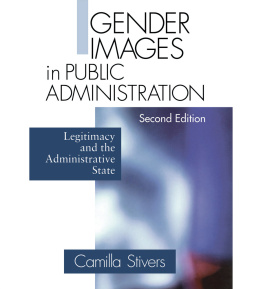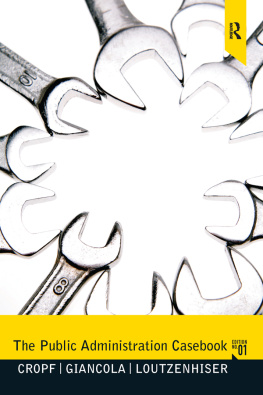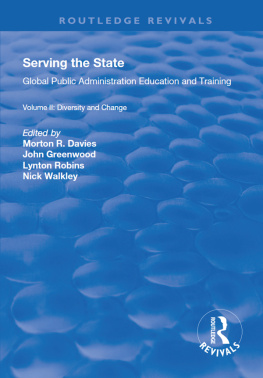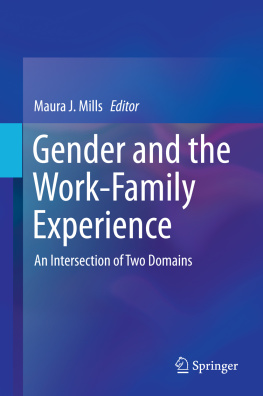All rights reserved. No part of this book may be reproduced or utilized in any form or by any means, electronic or mechanical, including photocopying, recording, or by any information storage and retrieval system, without permission in writing from the publisher
For information:
 | Sage Publications, Inc.
2455 Teller Road
Thousand Oaks, California 91320
E-mail:
Sage Publications Ltd.
6 Bonhill Street
London EC2A 4PU
United Kingdom
Sage Publications India Pvt. Ltd.
M-32 Market
Greater Kailash I
New Delhi 110 048 India |
Printed in the United States of America
Library of Congress Cataloging-in-Publication Data
Stivers, Camilla.
Gender images in public administration Legitimacy and the administrative state / by Camilla Stivers.--2nd ed.
p. cm.
ISBN 0-7619-2173-7 (c) -- ISBN 0-7619-2174-5 (p)
1. Women in public life--United States. 2. Women in the civil service--United States. 3. Sex role--United States. 4. Public administration--United States. I. Title.
HQ1391.U5 S75 2002
305.420973--dc21
2002001786
02 03 04 05 06 07 10 9 8 7 6 5 4 3 2 1
| Acquisitions Editor | : | Marquita Flemming |
| Editorial Assistant | : | MaryAnn Vail |
| Production Editor | : | Diana E. Axelsen |
| Copy Editor | : | Joyce Kuhn |
| Typesetter | : | Siva Math Setters, Chennai, India |
| Indexer | : | Jeanne Busemeyer |
| Cover Designer | : | Sandra Ng |
Preface
Quite often, when I talk to classes of public administration students about gender, someonewoman or mansays, Well, Im sure it was like that in the bad old days, but things have changed. More than any other single factor, this comment (heard over and over) led me to produce a second edition of Gender Images. The first edition was written in 1991 and came out in print in late 1992, so it has been nearly a decade since I did the supporting research. Perhaps, I thought, things had changed; at least I owed it to the students, and to other readers of the book, to find out. The result is this new edition, which incorporates data, research studies, and theoretical literature from the past 10 years.
Unhappily, although there are signs of progress in such indicators as the proportions of women at upper levels of federal, state, and local governments, in my judgment the big picture as seen in the fields writings looks pretty much the way it did 10 years ago. Public administration scholarship continues to rely on images that conform to widely accepted (though varied) notions of masculinity, and women are still struggling to manage their gender images (not too feminine, not too masculine) and to balance competing demands of work and family. And even more unhappily, with a few exceptions, by and large the literature in the field still neglects the issue of gender. If for no other reason, since it is common for a majority of the students in an MPA class to be women, we still seem to need a book that considers gender as a factor in public administrationand of course, there are lots of other reasons, as this book tries to show.
A few readers of the first edition responded to it by calling Gender Images a polemic. (A roughly equal number told me I was too timid.) My dictionary defines a polemic as a controversy or argument, esp. one that is a refutation of or an attack upon a specified opinion or doctrine, so I suppose in the main these critics are right, since my intent is certainly to make an argument and to stimulate controversy. The purpose of my project has never been to attack in an intemperate way, however, but rather to engage in a dialogue. I do accept what my experience tells me, that raising the issue of gender (let alone the topic of feminist theory) is liable to be viewed as an act of aggression in some quarters.
Some have characterized the work of a number of feminist critics of organizations, including mine, as arbitrary and biasedthat is, that we read in masculinities whenever [we] feel like it, ignore the factors that promote equality between the sexes, and in general oversensitize the issue of gender (Alvesson & Billing, 1997, pp. 7, 12, 86). Readers of this new edition must judge for themselves whether this is the case. It seems to me that broaching the subject of gender in a field where it has been virtually absent can only be seen as oversensitivity by those who would rather the topic not be discussed at all. I have tried to make my argument judiciously and in a spirit of self-criticism. Gender analysis is neither self-evident nor the most important framework within which to approach the study of public administration. I do insist that a feminist perspective on gender in organizations makes it possible to see certain aspects that other perspectives do not reveal. The significance of the feminist perspective in comparison with others, I leave for readers to decide for themselves.
Reaching the finish line of this edition, like the previous one, was made possible only with the help and support of many colleagues and friends. My husband, Ralph Hummel, not only makes my world but sometimes finds himself offering feminist perspectives. He is my best critic and best friend. Colleagues and students at Cleveland State University, the University of Akron, and the Evergreen State College took on the earlier edition in lively discussions, as did classes at a number of universities where I was lucky enough to have the opportunity to talk. Many scholars in the field have helped me sharpen and refine my arguments, whether they considered themselves fellow travelers or unbelievers. My thanks to (in no particular order) Mary Ellen Guy, David Farmer, Suzanne Mettler, Chuck Fox and Hugh Miller, Jay White, Celia Davies, David Carnevale, Mary Timney, Cynthia McSwain and Orion White, Ken Dolbeare, Cheryl Simrell King, Matthew Holden, Dolores Foley, David Rosenbloom, Jennifer Alexander, Guy Adams, Richard Box, April Hejka-Ekins, Larry Terry, Cindy Rosenthal, Dick Pratt, J. J. Hendricks, Joyce Outshoorn, Petra Schreurs, and an anonymous reviewer. Conversations at the 1994 conference on women and public policy, cosponsored by Erasmus University, Rotterdam, and the University of Leiden, were extraordinarily stimulating and helpful. A special thanks to Renee Nank, colleague and friend, whose help and support anchor and guide me in so many ways. Ruth-Ellen Joeres continues to be my home away from home. The book is better for the criticism and appreciation it has received; its deficiencies remain my responsibility.











